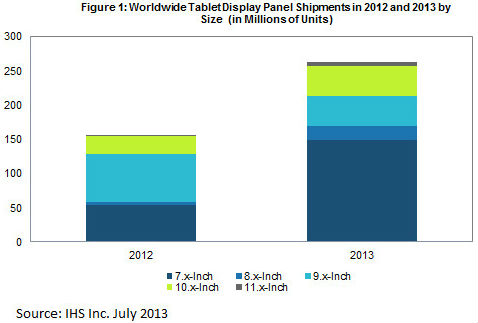 IHS has increased its forecast for tablet displays by six percent for 2013.
IHS has increased its forecast for tablet displays by six percent for 2013.
The numbers were boosted by orders from Chinese white-box tablet makers who seem to be growing at a much faster pace than big brands. A total of 262 million displays for tablets should be shipped this year, up from a previous forecast of 246 million units. Looking back at 2012, this represents 69 percent growth.
“Competitive dynamics in the tablet market have changed dramatically this year as Chinese white-box smartphone makers have entered the tablet market in droves,” Ricky Park, senior manager for large-area displays at IHS, said. “These companies are producing massive quantities of low-end tablets that appeal to consumers in China and other developing economies. Because of this, the white-box manufacturers are driving up demand for tablet panels”
Park noted that most white-box outfits are going for cheaper TN panels rather new IPS models. The figures also indicate that the market is gobbling up smaller tablets, with 7- to 8-inch screens, while the traditional iPad 9.7-inch format is falling out of favour. In addition, consumers on the prowl for cheap, compact tablets don’t appear to be badge snobs.
Coinciding with the shift to 7-inch devices, an increasing number of unbranded tablets are hitting the market. As many as 40 percent of all tablets shipped in April were unbranded, up from just 20 percent in the fourth quarter of 2012.
IHS found that white-box players hold a number of advantages over major brands. They can produce their products at lower cost, but at the same time they also have more flexibility in production. This results in more agility, as they are able to change their design quicker and take advantage of cheaper or better components once they hit the market.
With cheap panels and increasingly fast application processors manufactured by Chinese companies, they can easily come up with relatively competitive products based on off-the-shelf components, but won’t break the bank doing so.
IHS expects 7- to 8-inch tablets to see even more demand. The 8-inch space is becoming very popular, mostly due to the success of the iPad mini, which has a 7.8-inch display. It seems that 8-inch designs represent the middle ground, by offering a bit more real estate than 7-inchers, but in a much more compact package than 9.7-inch iPad rip-offs. IHS believes 8-inch tablets will grab a substantial piece of the pie by the end of the year.
Big tablets are by no means dead. They are simply evolving and the advent of Atom powered Windows 8 tablets could help boost sales. Even bigger Windows tablets are expected and eventually these 11.6-inch devices, with an added physical keyboard, could start replacing ultraportables in the near future. Since Windows still remains big in business, such designs could make inroads in the enterprise market.






